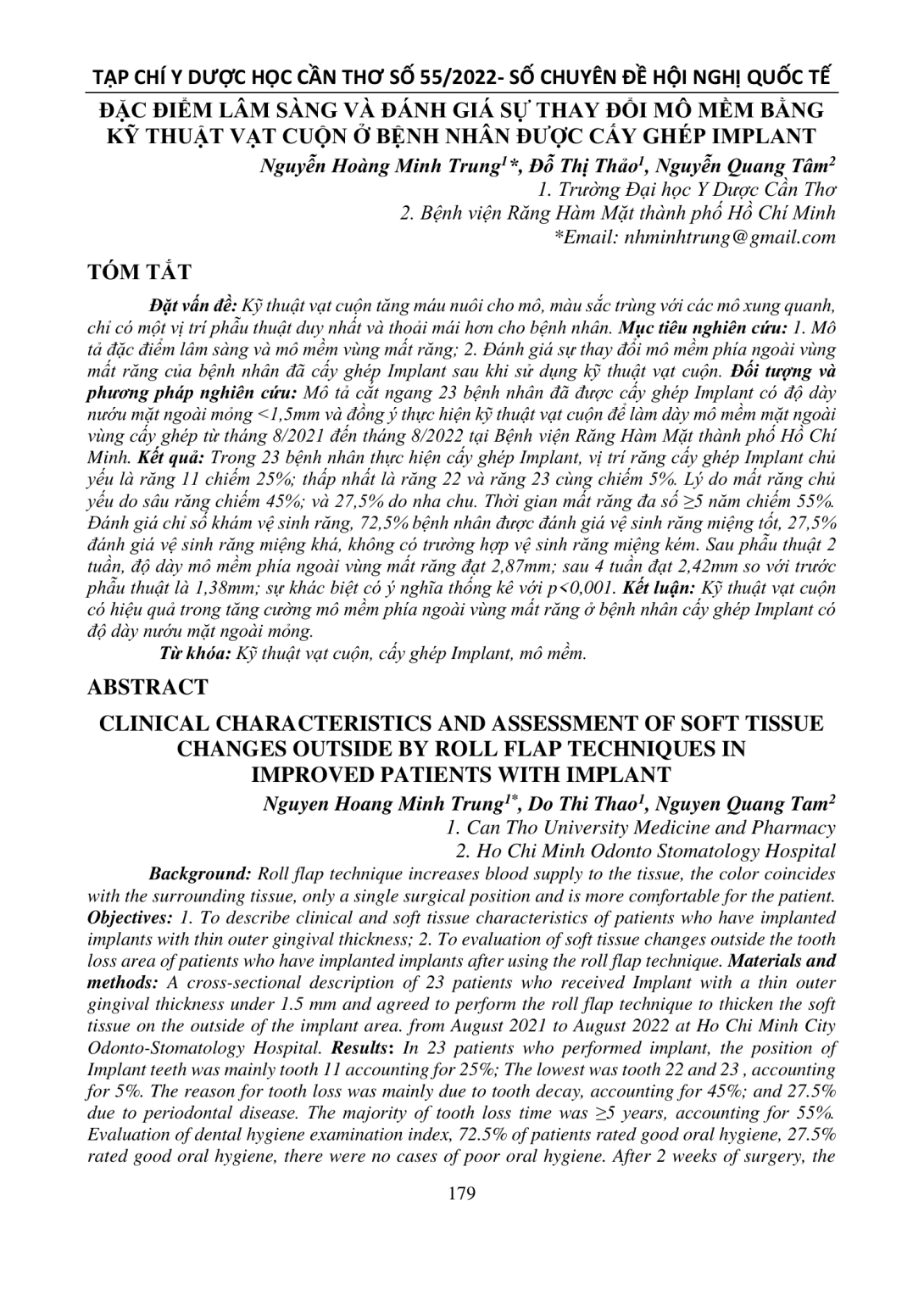
Mô tả đặc điểm lâm sàng và mô mềm vùng mất răng. Đánh giá sự thay đổi mô mềm phía ngoài vùng mất răng của bệnh nhân đã cấy ghép Implant sau khi sử dụng kỹ thuật vạt cuộn. Đối tượng và phương pháp nghiên cứu: Mô tả cắt ngang 23 bệnh nhân đã được cấy ghép Implant có độ dày nướu mặt ngoài mỏng <1,5mm và đồng ý thực hiện kỹ thuật vạt cuộn để làm dày mô mềm mặt ngoài vùng cấy ghép từ tháng 8/2021 đến tháng 8/2022 tại Bệnh viện Răng Hàm Mặt thành phố Hồ Chí Minh. Kết quả: Trong 23 bệnh nhân thực hiện cấy ghép Implant, vị trí răng cấy ghép Implant chủ yếu là răng 11 chiếm 25%; thấp nhất là răng 22 và răng 23 cùng chiếm 5%. Lý do mất răng chủ yếu do sâu răng chiếm 45%; và 27,5% do nha chu. Thời gian mất răng đa số ≥5 năm chiếm 55%. Đánh giá chỉ số khám vệ sinh răng, 72,5% bệnh nhân được đánh giá vệ sinh răng miệng tốt, 27,5% đánh giá vệ sinh răng miệng khá, không có trường hợp vệ sinh răng miệng kém. Sau phẫu thuật 2 tuần, độ dày mô mềm phía ngoài vùng mất răng đạt 2,87mm; sau 4 tuần đạt 2,42mm so với trước phẫu thuật là 1,38mm; sự khác biệt có ý nghĩa thống kê với p<0,001. Kết luận: Kỹ thuật vạt cuộn có hiệu quả trong tăng cường mô mềm phía ngoài vùng mất răng ở bệnh nhân cấy ghép Implant có độ dày nướu mặt ngoài mỏng.
Roll flap technique increases blood supply to the tissue, the color coincides with the surrounding tissue, only a single surgical position and is more comfortable for the patient. Objectives: 1. To describe clinical and soft tissue characteristics of patients who have implanted implants with thin outer gingival thickness; 2. To evaluation of soft tissue changes outside the tooth loss area of patients who have implanted implants after using the roll flap technique. Materials and methods: A cross-sectional description of 23 patients who received Implant with a thin outer gingival thickness under 1.5 mm and agreed to perform the roll flap technique to thicken the soft tissue on the outside of the implant area. from August 2021 to August 2022 at Ho Chi Minh City Odonto-Stomatology Hospital. Results: In 23 patients who performed implant, the position of Implant teeth was mainly tooth 11 accounting for 25%; The lowest was tooth 22 and 23 , accounting for 5%. The reason for tooth loss was mainly due to tooth decay, accounting for 45%; and 27.5% due to periodontal disease. The majority of tooth loss time was ≥5 years, accounting for 55%. Evaluation of dental hygiene examination index, 72.5% of patients rated good oral hygiene, 27.5% rated good oral hygiene, there were no cases of poor oral hygiene. After 2 weeks of surgery, the thickness of soft tissue outside the tooth loss area reached 2.87mm; after 4 weeks reached 2.42mm compared to before surgery was 1.38mm; The difference was statistically significant with p<0.001. Conclusion: Roll flap technique is effective in enhancing soft tissue outside the tooth loss area in Implant patients with thin outer gingival thickness
- Đăng nhập để gửi ý kiến
